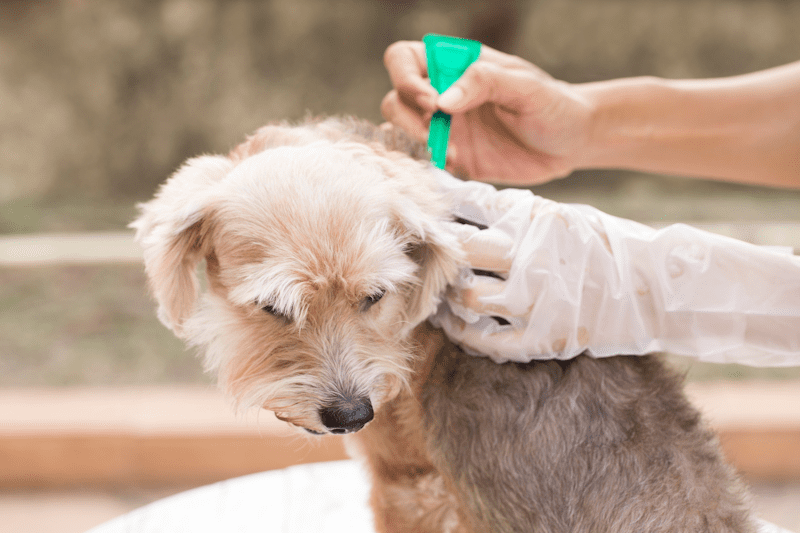Your pet will almost certainly encounter a flea or tick when out for a walk or playing in the grass, no matter how meticulously you take care of them, especially now that the weather is getting warmer in Chicago and more people are walking their dogs regularly. Therefore, maintaining a regular flea and tick prevention routine is essential for protecting your pets and property from these dangerous insects.
Infestations of fleas and ticks can be dangerous to your pet’s health. However, pet owners can save their dogs and cats from diseases like Rocky Mountain spotted fever, Lyme disease, skin infections, and discomfort by taking preventative measures against fleas and ticks.
Flea and tick prevention helps keep your dogs healthy and happy. It also protects your family and house from an infestation of pests.
Flea and tick protection comes in a wide range of forms. Oral drugs, topical creams, and aerosols are all viable options. Talking to your vet is the best method to determine what flea and tick protection is appropriate for your cat. Your veterinarian will advise you on the best preventative care for your pet based on its medical history and present condition.
Your pet’s annual checkup at the vet should include a discussion about flea and tick control. Your veterinarian can screen your pet for fleas and ticks now. Your veterinarian will consider your pet’s breed, age, current health status, and other relevant information before recommending a treatment plan.
Even while there are choices for treating fleas and ticks on your pet, the best way to ensure your pet’s health and happiness is to adopt preventative steps. Tick and fleas prevention is always ideal.
Ask your veterinarian about tick and flea prevention measures during your pet’s annual checkup. Based on your pet’s specific requirements, they can advise you on the best course of action.
Why Is It Important to Have a Tick and Fleas Prevention Routine?
Fleas can infest a dog after it has spent time in any space favorable to the parasite’s survival, such as a home with carpeting, a yard with leafy trash piles, or decks with constant shade. Tick and fleas prevention is crucial for pets.
Ticks only attach to dogs after exposure to tick habitats, such as tall grass or wooded areas. Getting rid of fleas and ticks is crucial because they can spread diseases. Preventatives are a class of drugs that can be given to your dog regularly to keep fleas and ticks at bay. They can be found in a wide range of convenient doses and packaging. Ask about these when you consult with us for tick and fleas prevention.
Ticks can transmit diseases such as Rocky Mountain spotted deer, ehrlichiosis, Lyme disease, and anaplasmosis, while fleas are known to spread tapeworm infections and skin infections (flea allergy dermatitis). The health of the people who live with and interact with pets is at risk if these pathogens are allowed to spread.
Various product choices are available for tick and fleas prevention. When deciding which product is best for you financially, you may want to consider the monthly per-dose cost variations. To be effective, flea and tick collars must make direct skin contact to repel pests and prevent tick attachment. Permethrin is a common ingredient in several topical solutions that keeps ticks away and stops them from attaching.
Ticks may still crawl on your pet even after using a topical treatment containing fipronil because it does not deter or prevent tick attachment. Ticks will not be killed until 24 hours after attachment.
Isoxazoline-based oral preventatives are part of tick and fleas prevention. While these do not preventing tick adhesion, kill ticks quickly. Diseases can be spread if any living ticks remain alive and attached to the animal. For Lyme disease to transfer from a tick to a dog, the tick must be attached for at least two to three days.
Common Ticks Found in Illinois
Ticks are arachnids, the same group as scorpions, spiders, and mites, despite popular belief to the contrary. All adult members of this clade walk on four legs but lack antennae. An adult insect has three sets of legs and one set of antennae. Ticks attach securely when sucking blood, eat slowly, and may go unnoticed for a considerable time, making them one of the most effective disease vectors. Feeding can take ticks several days.
Amblyomma americanum (Lone Star Tick)
Although the lone star tick is sometimes seen in northern Illinois, it is most common in the state’s southern half. Humans are among the many warm-blooded animals that the Lone Star Tick will feed upon.
The larva is hardly more prominent than the period at the end of this phrase, and that’s saying something! The nymph is around the size of a pinhead when detected in humans. Adults only grow to be approximately 1/8 of an inch long and are brown. There is a white patch in the center of the back of the adult female.
Ixodes scapularis (Deer Tick)
The three feeding stages of the Deer Tick can happen on a wide range of hosts, including humans. However, when the eggs hatch into tiny larvae in the spring, they eat primarily white-footed mice and other little mammals.
The larvae develop into brown nymphs the size of pinheads the following spring and prey on different warm-blooded animals. Finally, in the fall, they will molt into adults. Female Deer Ticks will lay eggs in spring.
Dermacentor variabilis (American Tick)
The American dog tick sometimes called the wood tick, is one of the most common. Mice and birds are among the larvae and nymphs’ preferred prey. However, the adult American dog tick can feed on small to big mammals, including humans.
Males and females that haven’t eaten in a while have a ruddy brown color and are about a third of an inch long. After feeding, females grow to roughly the size of a tiny grape, with a vast silvery patch behind their heads. The males of the species have thin silver stripes across their backs and don’t get much bigger after eating. Because males seem so different from females, they are sometimes misidentified as belonging to a different tick species.


